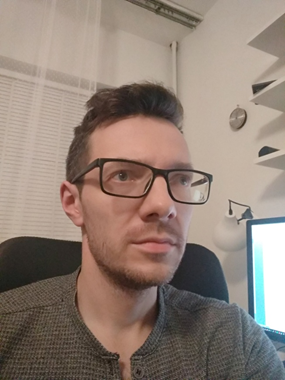Hi, I am Ilya Bruchkouski from Minsk Belarus and since August 2023 I am an adiunkt at the department of Atmospheric Physics.
My primary research interests are in the fields of optical remote sensing measurements: Differential Optical Absorption Spectroscopy (DOAS) and Multi-Axis Differential Optical Absorption Spectroscopy (MAX-DOAS) techniques, atmospheric radiation modelling, optical spectroscopy and optical design. I took part in the development of optical instrumentation for ground-based measurements in UV-Vis spectral range (320-470 nm), stratospheric ozone and nitrogen dioxide measurements in Antarctica, measurements of atmospheric aerosols and atmospheric trace gases, including SO2 in volcanic emissions, and worked in collaboration in the same fields with Max Planck Institute for Chemistry (MPIC) and A.M. Obukhov Institute of Atmospheric Physics. The main field of my work is consisted in the optical schemes designing, spectral instruments adjustments and spectrometers wavelength and absolute radiance calibrations. Also I was closely associated with the development of opto-mechanical parts and calibration activities of the open-air remote sensing spectral instruments in National Ozone Monitoring Research Center (Minsk, Belarus).
I had built my own MAX-DOAS instrument by 2012 and then took part in the MAD-CAT (Multi Axis Doas – Comparison campaign for Aerosols and Trace gases) international inter-comparison campaign funded by MPIC (Mainz, Germany). The MAD-CAT campaign had been going on for me for one month in 2013 and my MAX-DOAS instrument showed the good results.

After MAD-CAT campaign, I took part in the 6th Belarusian Antarctic Expedition with my self-made MAX-DOAS instrument (and 7 additional scientific instruments according to required scientific program), and it showed some interesting results I have included in my phD thesis as well as the MAD-CAT campaign results. Later, I took part in another international inter-comparison campaign funded by ESA and the Netherlands Space Office (CINDI-2: Cabauw Intercomparison of Nitrogen Dioxide Measuring Instruments, Cabauw, Netherlands, 2016) with modified version of my MAX-DOAS instrument (shifted in the UV-range). The CINDI-2 campaign had been going on only for two weeks in 2016 but was very useful for me in the field of spectral data processing.
In 2020 I defended my phD thesis: Methods for processing spectral data of instrument with multi-axis geometry for trace gases retrieval in the atmosphere. Optical design, DOAS analysis, radiative transfer modelling and field in-situ measurements of trace gases were the main part of my thesis.
My last workplace was A.N. Sevchenko Institute of Applied Physical Problems of the Belarusian State University, department of Aerospace Research, laboratory of optical-physical measurements which was connected with following activities: optical design, optimization, adjustments and calibrations of photo-spectral instrumentation for International Space Station, absolute calibrations of photo-spectral equipment for remote sensing applications (drone-born and air-born), optical fine adjustments and self-made spectrometers, building spectral equipment for the measurements of bi-directional spectral reflectance function in the lab facility.
My hobby is working on universal lathe and milling machine and similar equipment for metal processing including forging and melting. Another hobby is repairing old cars: engines, electrics, everything. Another hobby is working with chemicals mainly for creation of protective coatings for some produced parts (anodizing for aluminum and bluing for steel). Also I like woodcarving.

